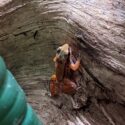
Trinidad Poison Dart Frog Natural History
Size
The Trinidad Poison Dart Frog can grow to between 2-2.8cm long.
Habitat and Distribution
The Trinidad Poison Dart Frog inhabits forest and wetland habitats with freshwater in northern and central Trinidad. The adult frogs are terrestrial but tadpoles are found in deep water.
Age
The lifespan of one of these frogs in the wild is unknown.
Diet
They are typically insectivores but they have been known to eat their own kind.
Groups and Breeding
Females lay between 2-12 eggs in rock crevices and 21 days later tadpoles will emerge from the eggs where the father frog will transport them on his back to a deep body of water. The tadpoles reach metamorphosis in around 56 days.
Threats
The Trinidad Poison Dart Frog is under threat from habitat loss and invasive species, however this species is currently not listed on the IUCN Red List.
Interesting Facts
It is also known as the ‘Yellow-throated Frog’. Despite them being a Poison Dart Frog, they are less toxic than other related poison dart frogs.
The Trinidad Poison Dart Frogs During Your Day Out in Kent
The Trinidad Poison Dart Frogs can be found in our new Reptile House living alongside the Alligator Snapping Turtles, opposite the Green Iguanas and next to the Burmese Python, Suzie.